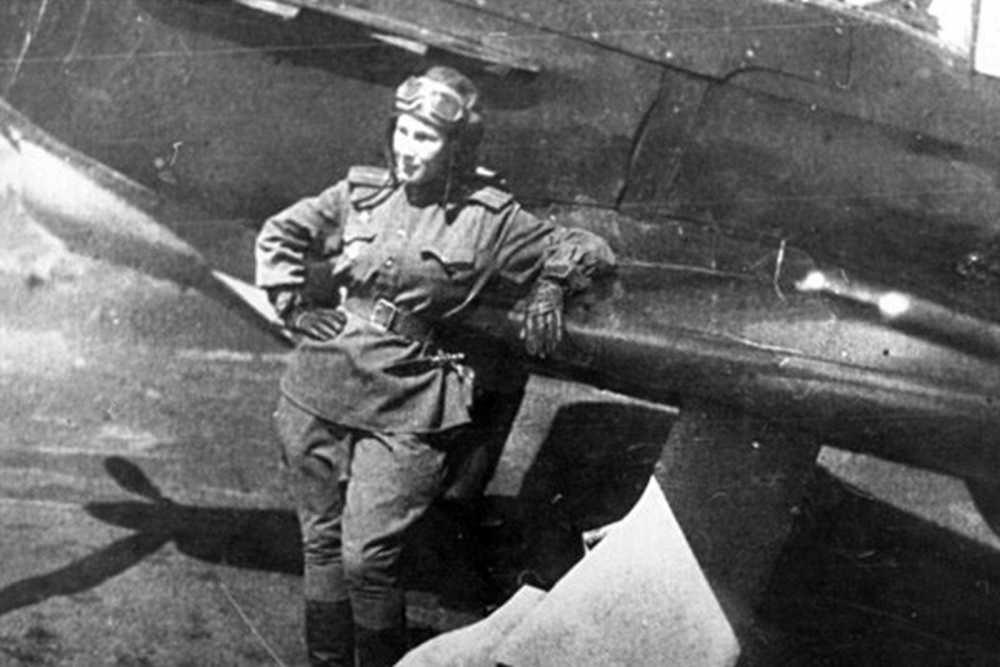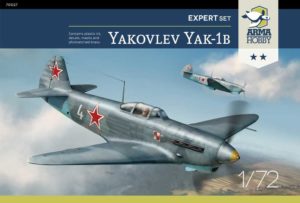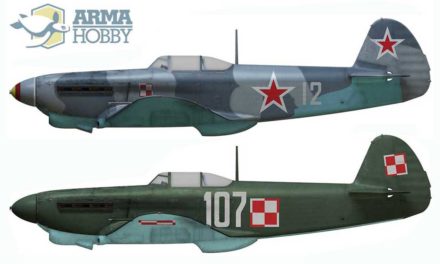The total war on the eastern front required the USSR to use all available forces to repel the German invasion and keep Stalin as the head of the state. Among millions of soldiers of the Red Army, there were also women. The most famous pilot was Lydia Vladimirovna Litvyak. Her favourite aeroplane was Yak-1 in two versions.
How to become a female pilot?
 Lydia Litvyak was born in Moscow in 1921. When she was 12, she became interested in aviation after she saw an air show organised in the Gorky Park in Moscow on the Airman Day. Two years later she joined the aero club, and later she became the flying instructor. To join the VVS, she had to cheat. Although the Soviet government claimed that there was gender equality, it was hard for women to reach prestigious jobs. Being a pilot in the Soviet Army was one of them. So how did this small blonde girl manage to do it?
Lydia Litvyak was born in Moscow in 1921. When she was 12, she became interested in aviation after she saw an air show organised in the Gorky Park in Moscow on the Airman Day. Two years later she joined the aero club, and later she became the flying instructor. To join the VVS, she had to cheat. Although the Soviet government claimed that there was gender equality, it was hard for women to reach prestigious jobs. Being a pilot in the Soviet Army was one of them. So how did this small blonde girl manage to do it?
It was not easy. Young aeroclub adept and the aviation instructor wanted to join the VVS at the beginning of the war, but it was not possible yet. On the 7th November 1941, after listening to Stalin’s fiery speech when the enemy was at the gates of Moscow, she tried again. She added 100 flying hours and joined an elite women’s unit – 586th IAP/PVO of newly formed by Marina Roskova women’s 12th Aviation Group.
From the very beginning, she was rebellious. She did not want to cut her hair, improved her uniform and added fur to her flying suit. And she often traded with the hospital and swapped her supplies to perhydrol to dye her hair. To do it, she used warm water from her Yak cooler.
Yak-1 Production No 4402, Yellow 44, flown by Lydia Litvyak in Spring 1943 (four aerial vicotries). From the left: L. Litvyak, K. Budanova and M. Kuznietsova. Photo: Yak Anthology.
The White Lily of Stalingrad
After she finished her training on U-2 and Yak -1, Lydia Litvyak and her friend Katya Budanova were promoted Sargent, and 586th IAP started protecting Saratov, a city on the Volga, north of Stalingrad, that was the Yak-1 fighters production center. Dance parties with pilots from other units relieved uneventful patrols without contact with the enemy. When Gen Paulus’s 6th Army attacked Stalingrad in September 1942, Liviak and Budanova with Maria Kuznetsova and Raisa Belayevan were sent to 437th IAP as replacements. On 13th September around 1000 German bombers attacked Stalingrad. The Soviets managed to send only third of that number. Litvya shot down one Ju 88 and later, when helping Bielayeva, a Bf 109G-6. According to the legend, Obfw Erwin Meier met his victor and could not believe that it was a woman.
Hitler’s struggle with Stalin’s city was not only the combat between soldiers, but also a propaganda battle. Lidya Litvyak, similar to Yeriomin and other pilots, became propaganda tools. Soviet propaganda permanently publicized their successes. It described Lidya as „the White Rose” Or „the White Lily” of Stalingrad. German pilots were well aware that women fought on the Soviet side as they saw them during combats. German propaganda soon found the explanation: „Soviets do not have enough pilots, so they send women to fight”.
Before the battle, the Soviet pilots were displeased that female pilots first received new Yak-1 fighters when they still had to use LaGG-3 fighters. But during the air battles over Stalingrad in September 1942 they changed their minds. Female pilots were transfer red to 9th GvIAP Flying Yak-1s. Litvyak did not manage to shoot down anything as she was flying as a wingman. Boris Yeriomin, regiment’s OC for a short time, called Litvyak “natural born fighter” and “aggressive personality”.
Lidya Litvyak flying Yak-1b No 23, 73rd Guard Fighter Aviation Regiment, Kurs Battle Summer 1943. Artwork by Marcin Górecki.
New Challanges
At the beginning of a new year, the regiment replaced Yaks with American Bell P-39 Airacobra, and four girls were transferred to 296th IAP (which soon became 73rd GvIAP) equipped with Yaks. There they heard that Marina Roskova died. Litvyak and Budanova flew in one section with regiment OC, Col. Baranov and Cpt. Aleksey Solomatin, who later became Litviak’s fiancé. After being promoted to Lieutenant, she became a squadron commander. The unit introduced new tactics – pilots flew free hunting missions in pairs. Litvyak and Solomatin often flew together, and soon they fall in love. During combats between Stalingrad and Rostov, Lidya witnessed several losses. “Daddy” Baranov was killed, and she was wounded in April 1941 and had to spend one month in Moscow on convalescence. After her return, another tragedy struck – she was a witness of Alexey Solomanin’s death. That was the last straw. Since that moment Her only aim was to fly combat missions and revenge. On 1st August 1943, during the Battle of Kursk, she did not return from the mission near Orel. According to Ivan Borysenko’s report, she did not see 8 Messerschmitts 109, which were escorting German bombers and was shot down. The case of Her death is still unclear, and even after finding Yak-1b wreck, some people still call into question circumstances of her death.
Lidya Litvyak, Summer 1943, 73 GIAP/Units and Planes (Russian text)
Table: Lidya Litvyak aerial victories according to Wikipedia
| Date |
Soviet Unit | Aircraft flown | Enemy Aircraft | Pilot & Fate | Enemy Unit |
| 13.09.1942 | 437 IAP | Yak-1 “White 02” | Ju.88 | unknown | |
| 13.09.1942 | 437 IAP | Yak-1 “White 02” | Bf 109G-2 W.Nr.13556 black 8 | Obfw. Erwin Meier – POW (11-kill ace) | 2./JG 53 |
| 14.09.1942 | 437 IAP | Yak-1 “White 02” | Bf 109 | unknown | |
| 27.09.1942 | 437 IAP | Yak-1 “White 02” | Ju.88A-4 W.Nr.3517 | Unknown (80% dam, w/o) | 5./KG 76 |
| 27.09.1942 | 437 IAP | Yak-1 “White 02” | Bf 109G-2 W.Nr.14221 | Horst Loose – KIA (shared) | 4./JG 52 |
| 11.02.1943 | 296 IAP | Yak-1 “Red 32” | Fw.190 | (shared) | unknown |
| 11.02.1943 | 296 IAP | Yak-1 “Red 32” | Ju 87D-3 W.Nr.2948 | Gerhard Weber + gunner – MIAs | 5./StG 77 |
| 22.03.1943 | 296 IAP | Yak-1 “Yellow 44” | Bf 109G-4 “BH+XB” | Lt. Franz Müller | 9./JG 3 |
| 22.03.1943 | 296 IAP | Yak-1 “Yellow 44” | Ju.88 | unknown | |
| 5.05.1943 | 73 GIAP | Yak-1 “Yellow 44” | Bf 109 | unknown | |
| 7.05.1943 | 73 GIAP | Yak-1 “Yellow 44” | Bf 109 | unknown | |
| 31.05.1943 | 73 GIAP | Yak-1 | Observation balloon | ||
| 16.07.1943 | 73 GIAP | Yak-1b “White 23” | Bf 109G-6 W.Nr.15204 | Unknown (20% dam) | 5./JG 3 |
| 16.07.1943 | 73 GIAP | Yak-1b “White 23” | Bf 109G-? W.Nr.? | ||
| 19.07.1943 | 73 GIAP | Yak-1b “White 23” | Bf 109G-6 W.Nr.20005 | Unknown (40% dam) | 5./JG 3 |
| 21.07.1943 | 73 GIAP | Yak-1b “White 23” | Bf 109 | unknown | |
| 1.08.1943 | 73 GIAP | Yak-1b “White 23” | Bf 109G-6 W.Nr.15852 | Unknown (50% dam) | 2./JG 52 |
| 1.08.1943 | 73 GIAP | Yak-1b “White 23” | Bf 109G-6 W.Nr.20423 white 3 | Fw. Hans-Jörg Merkle – KIA (30-kill ace)(shared) | 1./JG 52 |
Lidya Litvyak and her, Yak-1b No 23.
Lidya Litvyak aircraft
Lidya Litvyak flew Yak-1 and Yak-1b fighters. They wore standard black and green camouflage (AMT-6 Black and AMT-4 Green) with AMT-7 Blue-grey undersides. Yekaterina Polunina, Ltvyak’s mechanic, mentioned, that Litvyak’s first aircraft had creamy-yellow number 02 painted on fuselage sides. The most famous aircraft credited to her was Yak with tactical number 44 but, was assigned to Sgt Serafim Faloleyev. She flew it several times when her Yak was unserviceable. She was small, and that caused some problems for her. Whenever she changed a plane or when she borrowed one from another pilot she had to adjust rudder pedals to reach them and see anything from the cockpit during the flight. According to “The Yak Anthology” website, Litvyak also flew Yak “08”. In spring 1943 she received a completely new aircraft – a Yak-1b “23”. Its camouflage pattern differed from the one applied in the factory. Most probably that aircraft arrived in the units painted in winter camouflage, similar to all aeroplanes made in the winter 1942/43. Upper surfaces were painted green with white, washable, paint covering it. In spring, the white paint was removed, and black patches were added. She probably lost her life while flying that aeroplane on 1st August 1943. According to Borysenko, the tactical number of the aircraft was “18”. However, it is not confirmed.
Yak-1b No 23, last aeroplane flown by Lidya Litvyak. Artwork by Zbyszek Malicki.
Suggested Reading
- Russia’s Women Top Guns, Władymir Beljakow, Aviation History March 2002
- Biała Lilia ze Stalingradu, Przemysław Skulski, TW Historia 4/2020 link
- Lidia Litwiak. Najsłynniejsza pilotka myśliwska II wojny światowej, Dariusz Kaliński, link
- Yak Anthology, (Russian) link
You may be interested
- Yak-1b kits and accessories in Arma Hobby webstore go to shop
Modeller happy enough to work in his hobby. Seems to be a quiet Aspie but you were warned. Enjoys talking about modelling, conspiracy theories, Grand Duchy of Lithuania and internet marketing. Co-founder of Arma Hobby. Builds and paints figurines, aeroplane and armour kits, mostly Polish subject and naval aviation.
This post is also available in:
 polski
polski















An excellent read. Full of interesting facts unknown to me until now, about this amazing young woman. It’s too easy to forget that she was our ally and a very dangerous one at that. My compliments.